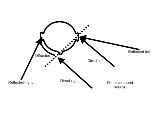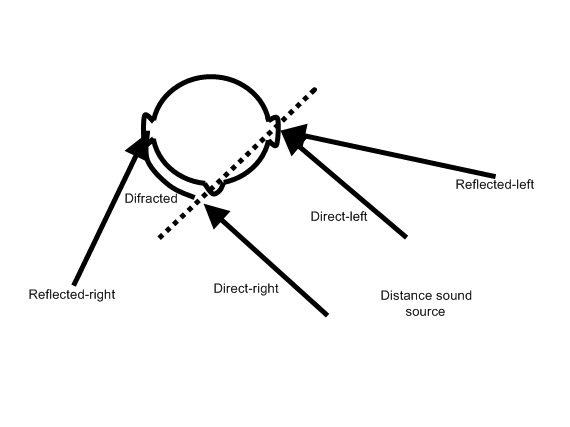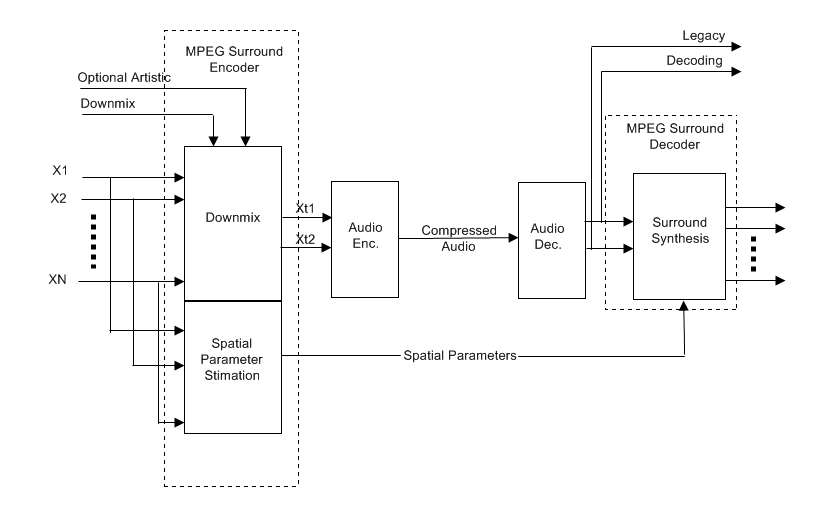
MPEG Surround
Encyclopedia
MPEG Surround also known as Spatial Audio Coding (SAC) is a lossy
compression
format
for surround sound
that provides a method for extending mono or stereo audio services to multi-channel audio in a backwards compatible fashion. The total bit rate
s used for the (mono or stereo) core and the MPEG Surround data are typically only slightly higher than the bit rate
s used for coding of the (mono or stereo) core.
MPEG Surround adds a side-information stream to the (mono or stereo) core bit stream, containing spatial image data. Legacy stereo playback systems will ignore this side-information while players supporting MPEG Surround decoding will output the reconstructed multi-channel audio.
Moving Picture Experts Group
(MPEG) issued a call for proposals on MPEG Spatial Audio Coding in March 2004. The group decided that the technology that would be the starting point in standardization process, would be a combination of the submissions from two proponents - Fraunhofer IIS / Agere Systems and Coding Technologies / Philips. The MPEG Surround standard was developed by the Moving Picture Experts Group (ISO/IEC JTC1
/SC29/WG11) and published as ISO/IEC 23003-1 in 2007. It was the first standard of MPEG-D standards group, formally known as ISO/IEC 23003 - MPEG audio technologies.
MPEG Surround was also defined as one of the MPEG-4 Audio Object Types in 2007. There is also the MPEG-4 Low Delay MPEG Surround object type (LD MPEG Surround), which was published in 2010. The Spatial Audio Object Coding (SAOC) was published as MPEG-D Part 2 - ISO/IEC 23003-2 in 2010 and it extends MPEG Surround standard by re-using its spatial rendering capabilities while retaining full compatibility with existing receivers. MPEG SAOC system allows users on the decoding side to interactively control the rendering of each individual audio object (e.g. individual instruments, vocals, human voices). There is also the Unified Speech and Audio Coding
(USAC) which will be defined in MPEG-D Part 3 - ISO/IEC 23003-3 and ISO/IEC 14496-3:2009/Amd 3. MPEG-D MPEG Surround parametric coding tools are integrated into the USAC codec.
The (mono or stereo) core could be coded with any (lossy
or lossless
) audio codec. Particularly low bitrates (64-96 kbit/s for 5.1 channels) are possible when using HE-AAC v2 as the core codec.
(ITD) and Interaural coherence (IC). This three concepts are illustrated in next image. Direct, or first-arrival, waveforms from the source hit the left ear at time, while direct sound received by the right ear is diffracted around the head, with time delay and level attenuation, associated. These two effects result in ITD and ILD are associated with the main source. At last, in a reverberant environment, reflected sound from the source, or sound from diffuse source, or uncorrelated sound can hit both ears, all of them are related with IC.


MPEG Surround encoder receives a multichannel audio signal,x1 to xN where the number of input channels is N. The most important aspect of the encoding process is that a downmix signal, xt1 and xt2, which is typically stereo, is derived from the multichannel input signal, and it is this downmix signal that is compressed for transmission over the channel rather than the multichannel signal. The encoder may be able to exploit the downmix process so as to be more advantageous. It not only creates a faithful equivalent of the multichannel signal in the mono or stereo downmix, but also creates the best possible multichannel decoding based on the downmix and encoded spatial cues as well. Alternatively, the downmix could be supplied externally (Artistic Downmix in before Diagram Block). The MPEG Surround encoding process could be ignored by the compression algorithm used for the transmitted channels (Audio Encoder and Audio Decoder in before Diagram Block). It could be any type of high-performance compression algorithms such as MPEG-1 Layer III, MPEG-4 AAC or MPEG-4 High Efficiency AAC, or it could even be PCM.
MPEG Surround also supports a mode in which the downmix is compatible with popular matrix surround decoders, such as Dolby Pro-Logic.
DRM+
was designed to be fully capable of transmitting MPEG Surround and such broadcasting was also successfully demonstrated.
MPEG Surround's backward compatibility and relatively low overhead provides one way to add multichannel sound to DAB without severely reducing audio quality or impacting other services.
Lossy data compression
In information technology, "lossy" compression is a data encoding method that compresses data by discarding some of it. The procedure aims to minimize the amount of data that need to be held, handled, and/or transmitted by a computer...
compression
Audio compression
Audio compression may refer to:*Audio compression , a type of lossy compression in which the amount of data in a recorded waveform is reduced for transmission with some loss of quality, used in CD and MP3 encoding, Internet radio, and the like...
format
Audio format
An audio format is a medium for storing sound and music. The term is applied to both the physical recording media and the recording formats of the audio content – in computer science it is often limited to the audio file format, but its wider use usually refers to the physical method used to...
for surround sound
Surround sound
Surround sound encompasses a range of techniques such as for enriching the sound reproduction quality of an audio source with audio channels reproduced via additional, discrete speakers. Surround sound is characterized by a listener location or sweet spot where the audio effects work best, and...
that provides a method for extending mono or stereo audio services to multi-channel audio in a backwards compatible fashion. The total bit rate
Bit rate
In telecommunications and computing, bit rate is the number of bits that are conveyed or processed per unit of time....
s used for the (mono or stereo) core and the MPEG Surround data are typically only slightly higher than the bit rate
Bit rate
In telecommunications and computing, bit rate is the number of bits that are conveyed or processed per unit of time....
s used for coding of the (mono or stereo) core.
MPEG Surround adds a side-information stream to the (mono or stereo) core bit stream, containing spatial image data. Legacy stereo playback systems will ignore this side-information while players supporting MPEG Surround decoding will output the reconstructed multi-channel audio.
Moving Picture Experts Group
Moving Picture Experts Group
The Moving Picture Experts Group is a working group of experts that was formed by ISO and IEC to set standards for audio and video compression and transmission. It was established in 1988 by the initiative of Hiroshi Yasuda and Leonardo Chiariglione, who has been from the beginning the Chairman...
(MPEG) issued a call for proposals on MPEG Spatial Audio Coding in March 2004. The group decided that the technology that would be the starting point in standardization process, would be a combination of the submissions from two proponents - Fraunhofer IIS / Agere Systems and Coding Technologies / Philips. The MPEG Surround standard was developed by the Moving Picture Experts Group (ISO/IEC JTC1
ISO/IEC JTC1
ISO/IEC JTC 1 is Joint Technical Committee 1 of the International Organization for Standardization and the International Electrotechnical Commission . It deals with all matters of information technology....
/SC29/WG11) and published as ISO/IEC 23003-1 in 2007. It was the first standard of MPEG-D standards group, formally known as ISO/IEC 23003 - MPEG audio technologies.
MPEG Surround was also defined as one of the MPEG-4 Audio Object Types in 2007. There is also the MPEG-4 Low Delay MPEG Surround object type (LD MPEG Surround), which was published in 2010. The Spatial Audio Object Coding (SAOC) was published as MPEG-D Part 2 - ISO/IEC 23003-2 in 2010 and it extends MPEG Surround standard by re-using its spatial rendering capabilities while retaining full compatibility with existing receivers. MPEG SAOC system allows users on the decoding side to interactively control the rendering of each individual audio object (e.g. individual instruments, vocals, human voices). There is also the Unified Speech and Audio Coding
Unified Speech and Audio Coding
Unified Speech and Audio Coding is an audio compression format and codec for both music and speech or any mix of speech and audio using very low bit rates between 12 and 64 kbit/s. It is currently under the development in MPEG and will be defined as an international standard ISO/IEC 23003-3...
(USAC) which will be defined in MPEG-D Part 3 - ISO/IEC 23003-3 and ISO/IEC 14496-3:2009/Amd 3. MPEG-D MPEG Surround parametric coding tools are integrated into the USAC codec.
The (mono or stereo) core could be coded with any (lossy
Lossy data compression
In information technology, "lossy" compression is a data encoding method that compresses data by discarding some of it. The procedure aims to minimize the amount of data that need to be held, handled, and/or transmitted by a computer...
or lossless
Lossless data compression
Lossless data compression is a class of data compression algorithms that allows the exact original data to be reconstructed from the compressed data. The term lossless is in contrast to lossy data compression, which only allows an approximation of the original data to be reconstructed, in exchange...
) audio codec. Particularly low bitrates (64-96 kbit/s for 5.1 channels) are possible when using HE-AAC v2 as the core codec.
Perception of sounds in space
MPEG Surround coding uses our capacity to perceive sound in the 3D and captures that perception in a compact set of parameters. Spatial perception is primarily attributed to three parameters, or cues, describing how humans localize sound in the horizontal plane: Interaural level differences(ILD), Interaural time differenceInteraural time difference
The interaural time difference when concerning humans or animals, is the difference in arrival time of a sound between two ears. It is important in the localisation of sounds, as it provides a cue to the direction or angle of the sound source from the head. If a signal arrives at the head from one...
(ITD) and Interaural coherence (IC). This three concepts are illustrated in next image. Direct, or first-arrival, waveforms from the source hit the left ear at time, while direct sound received by the right ear is diffracted around the head, with time delay and level attenuation, associated. These two effects result in ITD and ILD are associated with the main source. At last, in a reverberant environment, reflected sound from the source, or sound from diffuse source, or uncorrelated sound can hit both ears, all of them are related with IC.

Description
MPEG Surround uses interchannel differences in level, phase and coherence equivalent to the ILD, ITD and IC parameters. The spatial image is captured by a multichannel audio signal relative to a transmitted downmix signal. These parameters are encoded in a very compact form so as to decode the parameters and the transmitted signal and to synthesize a high quality multichannel representation.
MPEG Surround encoder receives a multichannel audio signal,x1 to xN where the number of input channels is N. The most important aspect of the encoding process is that a downmix signal, xt1 and xt2, which is typically stereo, is derived from the multichannel input signal, and it is this downmix signal that is compressed for transmission over the channel rather than the multichannel signal. The encoder may be able to exploit the downmix process so as to be more advantageous. It not only creates a faithful equivalent of the multichannel signal in the mono or stereo downmix, but also creates the best possible multichannel decoding based on the downmix and encoded spatial cues as well. Alternatively, the downmix could be supplied externally (Artistic Downmix in before Diagram Block). The MPEG Surround encoding process could be ignored by the compression algorithm used for the transmitted channels (Audio Encoder and Audio Decoder in before Diagram Block). It could be any type of high-performance compression algorithms such as MPEG-1 Layer III, MPEG-4 AAC or MPEG-4 High Efficiency AAC, or it could even be PCM.
Legacy compatibility
The MPEG Surround technique allows for compatibility with existing and future stereo MPEG decoders by having the transmitted downmix (e.g. stereo) appear to stereo MPEG decoders to be an ordinary stereo version of the multichannel signal. Compatibility with stereo decoders is desirable since stereo presentation will remain pervasive due to the number of applications in which listening is primarily via headphones, such as portable music players.MPEG Surround also supports a mode in which the downmix is compatible with popular matrix surround decoders, such as Dolby Pro-Logic.
Digital Audio Broadcasting
Due to the relatively small channel bandwidth, the relatively large cost of transmission equipment and transmission licenses and the desire to maximize user choices by providing many programs, the majority of existing or planned digital broadcasting systems cannot provide multichannel sound to the users.DRM+
Digital Radio Mondiale
Digital Radio Mondiale is a set of digital audio broadcasting technologies designed to work over the bands currently used for AM broadcasting, particularly shortwave...
was designed to be fully capable of transmitting MPEG Surround and such broadcasting was also successfully demonstrated.
MPEG Surround's backward compatibility and relatively low overhead provides one way to add multichannel sound to DAB without severely reducing audio quality or impacting other services.
Digital TV Broadcasting
Currently, the majority of digital TV broadcasts use stereo audio coding. MPEG Surround could be used to extend these established services to surround sound, as with DAB.Music download service
Currently, a number of commercial music download services are available and working with considerable commercial success. Such services could be seamlessly extended to provide multichannel presentations while remaining compatible with stereo players: on computers with 5.1 channel playback systems the compressed sound files are presented in surround sound while on portable players the same files are reproduced in stereo.Streaming music service / Internet radio
Many Internet radios operate with severely constrained transmission bandwidth, such that they can offer only mono or stereo content. MPEG Surround Coding technology could extend this to a multichannel service while still remaining within the permissible operating range of bitrates. Since efficiency is of paramount importance in this application, compression of the transmitted audio signal is vital. Using recent MPEG compression technology (MPEG-4 High Efficiency Profile coding), full MPEG Surround systems have been demonstrated with bitrates as low as 48 kbit/s.External links
- MPEG Surround
- Official MPEG web site
- RFC 5691 - RTP Payload Format for Elementary Streams with MPEG Surround Multi-Channel Audio

